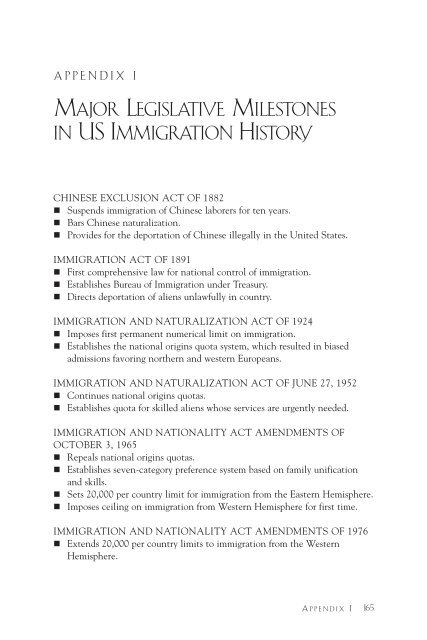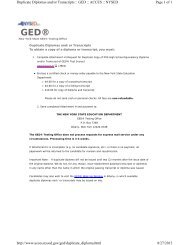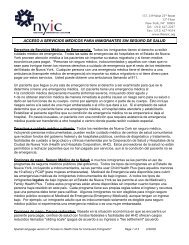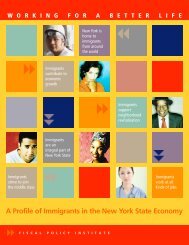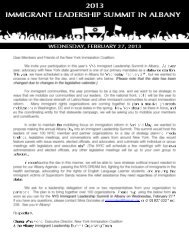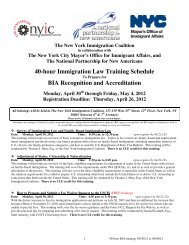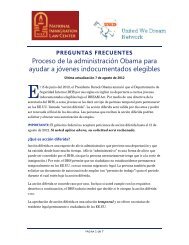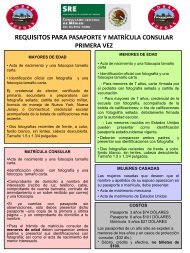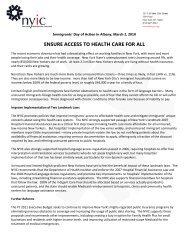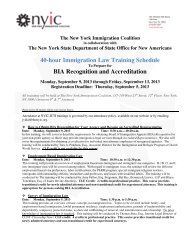Major Legislative Milestones in US Immigration History - New York ...
Major Legislative Milestones in US Immigration History - New York ...
Major Legislative Milestones in US Immigration History - New York ...
You also want an ePaper? Increase the reach of your titles
YUMPU automatically turns print PDFs into web optimized ePapers that Google loves.
APPENDIX I<strong>Major</strong> <strong>Legislative</strong> <strong>Milestones</strong><strong>in</strong> <strong>US</strong> <strong>Immigration</strong> <strong>History</strong>CHINESE EXCL<strong>US</strong>ION ACT OF 1882 Suspends immigration of Ch<strong>in</strong>ese laborers for ten years. Bars Ch<strong>in</strong>ese naturalization. Provides for the deportation of Ch<strong>in</strong>ese illegally <strong>in</strong> the United States.IMMIGRATION ACT OF 1891 First comprehensive law for national control of immigration. Establishes Bureau of <strong>Immigration</strong> under Treasury. Directs deportation of aliens unlawfully <strong>in</strong> country.IMMIGRATION AND NATURALIZATION ACT OF 1924 Imposes first permanent numerical limit on immigration. Establishes the national orig<strong>in</strong>s quota system, which resulted <strong>in</strong> biasedadmissions favor<strong>in</strong>g northern and western Europeans.IMMIGRATION AND NATURALIZATION ACT OF JUNE 27, 1952 Cont<strong>in</strong>ues national orig<strong>in</strong>s quotas. Establishes quota for skilled aliens whose services are urgently needed.IMMIGRATION AND NATIONALITY ACT AMENDMENTS OFOCTOBER 3, 1965 Repeals national orig<strong>in</strong>s quotas. Establishes seven-category preference system based on family unificationand skills. Sets 20,000 per country limit for immigration from the Eastern Hemisphere. Imposes ceil<strong>in</strong>g on immigration from Western Hemisphere for first time.IMMIGRATION AND NATIONALITY ACT AMENDMENTS OF 1976 Extends 20,000 per country limits to immigration from the WesternHemisphere.A p p e ndix I 165
REFUGEE ACT OF 1980 Sets up first permanent and systematic procedure for admitt<strong>in</strong>g refugees. Removes refugees as a category from preference system. Def<strong>in</strong>es refugee accord<strong>in</strong>g to <strong>in</strong>ternational, versus ideological, standards. Establishes process of domestic resettlement. Codifies asylum status.IMMIGRATION REFORM AND CONTROL ACT OF 1986 Institutes employer sanctions for know<strong>in</strong>gly hir<strong>in</strong>g illegal aliens. Creates legalization programs. Increases border enforcement. Creates $4 Billion State Legalization Impact Assistance Grant Program.IMMIGRATION ACT OF 1990 Increases legal immigration ceil<strong>in</strong>gs by 40 percent and triples employmentbasedimmigration. Creates diversity admissions category. Establishes temporary protected status for those <strong>in</strong> the United States jeopardizedby armed conflict or natural disasters <strong>in</strong> their native countries.ILLEGAL IMMIGRATION REFORM AND IMMIGRANTRESPONSIBILITY ACT OF 1996 Increases penalties for alien smuggl<strong>in</strong>g and document fraud. Provides for expedited removal of <strong>in</strong>admissible aliens. Bars unlawfully present immigrants from re-entry for longer periods of time. Sets <strong>in</strong>come requirements for immigrant sponsors at 125 percent of federalpoverty level.This chart has been updated s<strong>in</strong>ce its orig<strong>in</strong>al publication <strong>in</strong> Sett<strong>in</strong>g the Record Straight, by M. E. Fix andJ. S. Passel (Wash<strong>in</strong>gton, DC: The Urban Institute, 1994). It is repr<strong>in</strong>ted here with permission fromThe Urban Institute.166S ecur<strong>in</strong>g the Future: <strong>US</strong> Immigrant Integration Policy
APPENDIX IIAccess to Health Careafter <strong>Immigration</strong> Reform:Lessons from <strong>New</strong> <strong>York</strong>ADAM GURVITCH<strong>Immigration</strong> reform could affect millions of American workers, public andprivate health care providers, <strong>in</strong>surers, and public health. Among otherth<strong>in</strong>gs, reform could create new categories of temporary workers, <strong>in</strong>crease thenumber of lawful permanent residents, and change the treatment of unauthorizedresidents. This appendix focuses on access to health care and presents theauthor’s practical considerations for policymakers who must plan for the consequencesof reforms at state and local levels. Examples from the state of <strong>New</strong><strong>York</strong> are used to illustrate how options for immigrants’ health care access mightbe implemented.Guid<strong>in</strong>g Pr<strong>in</strong>ciplesWhatever approach is chosen to provide health care access for participants <strong>in</strong>an immigration reform program, the follow<strong>in</strong>g pr<strong>in</strong>ciples should guide reform: Do not add to the ranks of the un<strong>in</strong>sured. Favor the simplest, least costly adm<strong>in</strong>istrative structures. Consider the <strong>in</strong>terests of both healthy <strong>in</strong>dividuals and those who havemedical needs. Do not weaken employer-based health <strong>in</strong>surance coverage. Strengthen the health care safety net for everyone <strong>in</strong> the community.A ppendix II 167
Key Design ElementsIn th<strong>in</strong>k<strong>in</strong>g about how to structure access to health care at the local level fortemporary workers and other <strong>in</strong>dividuals who participate <strong>in</strong> an immigrationreform program, the follow<strong>in</strong>g considerations are important:STAKEHOLDER INVESTMENTEmployer and employee assessments or contributions are assumed to be the primarysource of fund<strong>in</strong>g for access to health care when discuss<strong>in</strong>g policy options. <strong>Immigration</strong>reform that is designed to benefit employers and workers should come with theexpectation that each will contribute to ensur<strong>in</strong>g adequate access to health care.Employers that provide health <strong>in</strong>surance benefits to workers who benefit from immigrationreform could be granted an offset or credit aga<strong>in</strong>st the employer’s assessedcost of participat<strong>in</strong>g <strong>in</strong> the immigration program (payment of fees, for example).FAIRNESS IN TAXATIONWorkers who reside <strong>in</strong> the United States and pay federal <strong>in</strong>come taxes shouldbe able to obta<strong>in</strong> federal means-tested public benefits on the same basis as anyother American if they fall on hard times. This basic fairness is especially relevantwhen faced with urgently needed, expensive medical care. 1ACCESS TO EMERGENCY CAREEmergency medical transportation and emergency health care are generallyextended to all persons <strong>in</strong> the United States experienc<strong>in</strong>g an emergency medicalcondition, uphold<strong>in</strong>g our long-stand<strong>in</strong>g respect for basic human decency;immigration reform should reta<strong>in</strong> this commitment to all <strong>US</strong> residents. 2STOP-LOSS PROTECTION FOR CATASTROPHIC CAREMedical care is extremely expensive for the vast majority of Americans and isdist<strong>in</strong>ct <strong>in</strong> nature from other types of expenses and debts because medical careis often <strong>in</strong>curred <strong>in</strong>voluntarily. <strong>US</strong> citizens ga<strong>in</strong> access to Medicaid if they havelimited <strong>in</strong>come and exhaust their disposable resources. 3 Migrants admitted1 For a description of the restrictions currently imposed on legal immigrants’ access to Medicaid and the StateChildren’s Health Insurance Program (SCHIP), see the <strong>US</strong> Department of Health and Human Services,Centers for Medicare and Medicaid Services (CMS) Web site:http://www.cms.hhs.gov/MedicaidEligibility/05_Immigrants.asp#TopOfPage.2 42 U.S.C. § 1395dd. <strong>US</strong> Department of Health and Human Services, Centers for Medicare and MedicaidServices (CMS) Emergency Medical Treatment and Labor Act (EMTALA) Web site:http://www.cms.hhs.gov/EMTALA.3 <strong>US</strong> Department of Health and Human Services, Centers for Medicare and Medicaid Services (CMS) Website: http://www.cms.hhs.gov/home/medicaid.asp. See also, “The Medicaid Program At a Glance”(Wash<strong>in</strong>gton, DC: Kaiser Commission on Medicaid and the Un<strong>in</strong>sured, Henry J. Kaiser Family Foundation,2005), http://www.kff.org/medicaid/upload/The-Medicaid-Program-at-a-Glance-Fact-Sheet.pdf.168S ecur<strong>in</strong>g the Future: <strong>US</strong> Immigrant Integration Policy
under immigration reform will need some form of stop-loss protection aga<strong>in</strong>stcatastrophic medical costs; options <strong>in</strong>clude Medicaid, 4 Medicare, or restrictedscope Medical Assistance for an emergency medical condition (“emergencyMedicaid”). 5 This protection will also ensure that safety net health providersare reimbursed, at least <strong>in</strong> part, for the costs of treat<strong>in</strong>g low-<strong>in</strong>come patients.RESIDENCYParticipants <strong>in</strong> immigration reform should be treated at least as favorably as H-1 visa holders for the purposes of participat<strong>in</strong>g <strong>in</strong> programs and services thatcurrently impose a state or local residency requirement. Examples of programsthat require proof of residency but not legal status <strong>in</strong>clude public health services,federally qualified health centers, hospital reimbursement for the treatmentof an emergency medical condition through “emergency Medicaid,” and, <strong>in</strong>states such as <strong>New</strong> <strong>York</strong>, free or subsidized <strong>in</strong>surance for children, pregnantwomen, and <strong>in</strong>dividuals liv<strong>in</strong>g with HIV and AIDS. 6PUBLIC NOTICEThe nation’s experience with the recent drug reimbursement or MedicarePart D program clearly demonstrates how important it will be for the governmentto provide clear <strong>in</strong>structions about health programs to participants <strong>in</strong>immigration reform. Clear communications will be vital to address<strong>in</strong>g concernsand misconceptions that lead many foreign-born <strong>in</strong>dividuals to avoidus<strong>in</strong>g health programs. 7Policy OptionsAccess to health care is important to workers, employers, and communitiesalike. Public health is safeguarded only when all members of a community arewill<strong>in</strong>g to come forward for screen<strong>in</strong>g and treatment <strong>in</strong> the event of an epidemicor biological or chemical exposure. Employers experience workers’ illness,4 The federal Medicaid program’s medically needy (MN) option allows states to extend Medicaid eligibility topersons whose <strong>in</strong>come and/or resources are above the eligibility level set by their state. Persons may qualifyimmediately or may “spend down” by <strong>in</strong>curr<strong>in</strong>g medical expenses that reduce their <strong>in</strong>come to or below theirstate’s MN <strong>in</strong>come level. Thirty-five states have adopted the medically needy option, and the rema<strong>in</strong><strong>in</strong>gstates have Medicaid for people who are “near poor.” More <strong>in</strong>formation can be found at:http://www.cms.hhs.gov/MedicaidGenInfo/03_TechnicalSummary.asp#TopOfPage.5 J. Perk<strong>in</strong>s, “Medicaid Coverage of Emergency Medical Conditions,” Clear<strong>in</strong>ghouse Review Journal of PovertyLaw and Policy 384 (Sept/Oct 2004).6 <strong>New</strong> <strong>York</strong> State, Department of Health — Medical Assistance Program: GIS 04 MA/003 Attachment 1,2004.7 T. Bauer, J. Bergman, C. Hill, J. Fuld, and L. Weiss, “Access to Health Insurance and Health Carefor Children <strong>in</strong> Immigrant Families” (<strong>New</strong> <strong>York</strong>: The <strong>New</strong> <strong>York</strong> Academy of Medic<strong>in</strong>e, publicationforthcom<strong>in</strong>g).A ppendix II 169
<strong>in</strong>jury, and disability as lost productivity and <strong>in</strong>creased tra<strong>in</strong><strong>in</strong>g and recruitmentcosts. <strong>US</strong> residents who cannot afford health care avoid seek<strong>in</strong>g it untilfaced with an emergency, result<strong>in</strong>g <strong>in</strong> a less healthy, less effective population.This paper presents five alternatives for achiev<strong>in</strong>g vary<strong>in</strong>g levels of access tohealth care under immigration reform, with the goals of ma<strong>in</strong>ta<strong>in</strong><strong>in</strong>g a healthyworkforce and protect<strong>in</strong>g public health and the f<strong>in</strong>ancial soundness of the <strong>US</strong>health care system.Option One: Insurance Buy-InIndividuals who participate <strong>in</strong> an immigration reform program would beallowed or required to enroll <strong>in</strong> one of the follow<strong>in</strong>g exist<strong>in</strong>g health coverageprograms by pay<strong>in</strong>g a group-rated premium: employer-based <strong>in</strong>surance, stateemployee health <strong>in</strong>surance plans, Medicaid, or Medicare.Under the health <strong>in</strong>surance buy-<strong>in</strong> option, both employers and participants <strong>in</strong>immigration reform would be assessed a fee or would pay a “premium,” withadditional contributions required on behalf of any dependents. Employers’ contributionswould receive the same favorable federal and state tax treatment currently<strong>in</strong> place, constitut<strong>in</strong>g a government subsidy of health benefits providedby private-sector employers.An <strong>in</strong>surance buy-<strong>in</strong> is an attractive option for provid<strong>in</strong>g affordable access to afull range of health services, and can potentially strengthen the public and private<strong>in</strong>surance systems. Temporary workers and other participants <strong>in</strong> immigrationreform will presumably be required to pass a medical screen<strong>in</strong>g prior toobta<strong>in</strong><strong>in</strong>g permission from the federal government to reside and work <strong>in</strong> theUnited States. By def<strong>in</strong>ition, this population will generally be <strong>in</strong> better healthand less likely than <strong>US</strong>-born citizens to be disabled, chronically and persistentlyill, impaired, unable to work, or elderly. 8 It is axiomatic that 20 percent ofthe population generates 80 percent of all health care expenses <strong>in</strong> the UnitedStates. Add<strong>in</strong>g a large number of healthy <strong>in</strong>dividuals to the exist<strong>in</strong>g populationof an <strong>in</strong>surance pool would favorably distribute risks and conta<strong>in</strong> the cost of<strong>in</strong>surance premiums, while promot<strong>in</strong>g solvency.<strong>New</strong> <strong>York</strong> State’s Child Health Plus program provides an example of a successful<strong>in</strong>surance buy-<strong>in</strong> model; the program provides coverage for preventive, primary,and emergency services to any un<strong>in</strong>sured <strong>New</strong> <strong>York</strong> State resident8 T. Norgren, “Mexicans <strong>in</strong> <strong>New</strong> <strong>York</strong> City: Demographics and Health of the City’s Fastest Grow<strong>in</strong>g HispanicGroup” (<strong>New</strong> <strong>York</strong>: Medical and Health Research Association of <strong>New</strong> <strong>York</strong> City, publication forthcom<strong>in</strong>g).170S ecur<strong>in</strong>g the Future: <strong>US</strong> Immigrant Integration Policy
younger than 19. 9 The program allows families that earn too much to qualifyfor children’s Medicaid to purchase group-rated <strong>in</strong>surance coverage for un<strong>in</strong>suredchildren through the state’s Child Health Plus program.Monthly <strong>in</strong>surance premiums <strong>in</strong> the Child Health Plus program vary by family<strong>in</strong>come, with the highest monthly premium set at roughly $150 for a quality <strong>in</strong>suranceplan with modest co-pays; a level more affordable than health plans with comparablebenefits available for the same population through the private <strong>in</strong>surancemarket. Enrollment <strong>in</strong> the program has been high among low- and middle-<strong>in</strong>comefamilies that do not receive health coverage through their employers. The ChildHealth Plus buy-<strong>in</strong> program essentially provides universal health coverage to un<strong>in</strong>sured<strong>New</strong> <strong>York</strong>ers through age 18, regardless of immigration status. The programconsistently receives bi-partisan political support throughout <strong>New</strong> <strong>York</strong> state.While the United States spends more per capita on health care than any othercountry, many <strong>US</strong> residents are unable to access care, and for many who do,the f<strong>in</strong>ancial consequences can be devastat<strong>in</strong>g: Medical debt is a lead<strong>in</strong>g causeof bankruptcy and homelessness <strong>in</strong> the United States. 10 Many people who workf<strong>in</strong>d it difficult or impossible to receive adequate medical care without health<strong>in</strong>surance; this is true not only for life-sav<strong>in</strong>g treatments but also for the rout<strong>in</strong>emanagement of chronic conditions.While immigrants are as likely to be employed as native-born citizens, immigrantsare three times as likely to lack <strong>in</strong>surance, and immigrant workers aremuch less likely than native-born workers to receive health <strong>in</strong>surance coveragethrough their employers. 11 Immigrants work the most dangerous jobs, with thefewest workplace protections, for the lowest wages <strong>in</strong> the labor market. 12 Manyimmigrant <strong>New</strong> <strong>York</strong>ers become at-risk for health problems when they enterthe workforce; immigrants account for nearly 40 percent of workplace deaths <strong>in</strong><strong>New</strong> <strong>York</strong> state. 13 A ppendix II 1719 Information about <strong>New</strong> <strong>York</strong> State’s Child Health Plus program can be found at the <strong>New</strong> <strong>York</strong> City Web site:http://www.nyc.gov/html/hia/html/public_<strong>in</strong>surance/children.shtml.10 The Access Project, “Home Sick,” 2005, http://www.accessproject.org/medical.html.11 R. Capps, M. Fix, J. Passel, J. Ost, and D. Perez-Lopez, “A Profile of the Low-Wage Immigrant Workforce”(Wash<strong>in</strong>gton, DC: The Urban Institute, 2003); M. Fix and R. Capps, “Immigrant Well-Be<strong>in</strong>g <strong>in</strong> <strong>New</strong> <strong>York</strong>and Los Angeles” (Wash<strong>in</strong>gton, DC: The Urban Institute, 2002).12 S. Richardson, “Fatal Work Injuries Among Foreign-Born Hispanic Workers,” <strong>US</strong> Department of Labor,Bureau of Labor Statistics, Monthly Labor Review (October 2005), http://www.bls.gov/opub/mlr/2005/10/ressum.pdf.13 Accord<strong>in</strong>g to the <strong>US</strong> Bureau of Labor Statistics, 39 percent of fatal occupational <strong>in</strong>juries <strong>in</strong> <strong>New</strong> <strong>York</strong> State<strong>in</strong> 2000, and 67 percent of fatal occupational <strong>in</strong>juries <strong>in</strong> <strong>New</strong> <strong>York</strong> City were immigrant workers. See <strong>New</strong><strong>York</strong> State Trial Lawyers Association, “<strong>New</strong> <strong>York</strong>’s “Scaffold Law”: An Essential Protection for ImmigrantConstruction Workers,” 2004.
Most legal immigrants arriv<strong>in</strong>g <strong>in</strong> the United States s<strong>in</strong>ce August 22, 1996, arecategorically barred for five years from receiv<strong>in</strong>g federal means-tested publicbenefits, <strong>in</strong>clud<strong>in</strong>g the Medicaid and SCHIP health programs. 14 These barsrema<strong>in</strong> <strong>in</strong> place despite the fact that these <strong>in</strong>dividuals — lawful permanent residents— are authorized to work and required to pay taxes that directly subsidizeothers’ health benefits. <strong>Immigration</strong> reform, whether <strong>in</strong> the form of atemporary worker program, earned legalization program, or a broad expansion<strong>in</strong> permanent visas, will achieve greater legitimacy if it corrects the failure ofearlier policies that prevent legal immigrants from access<strong>in</strong>g safety net supportsdur<strong>in</strong>g times of hardship.Many <strong>New</strong> <strong>York</strong>ers, <strong>in</strong>clud<strong>in</strong>g hundreds of thousands of immigrants, earn toomuch to qualify for public coverage, too little to afford private coverage, and lackaffordable coverage through their employers. 15 Any proposal aimed at ensur<strong>in</strong>gaccess to affordable health care for the participants <strong>in</strong> immigration reform mustalso take <strong>in</strong>to account the situation fac<strong>in</strong>g other un<strong>in</strong>sured Americans, <strong>in</strong>clud<strong>in</strong>gthe <strong>US</strong>-born. That said, foreign-born residents who are permitted to live andwork <strong>in</strong> the United States must have access to affordable health care <strong>in</strong> order toavoid circumstances of extreme <strong>in</strong>equity and exploitation.A basic assumption is that the immigration reform programs will be designedwith the rights of all workers <strong>in</strong> m<strong>in</strong>d and will not underm<strong>in</strong>e work<strong>in</strong>g conditionsfor any segment of the workforce — newly m<strong>in</strong>ted or well-established. Itis crucial to ensure that employers who already provide health <strong>in</strong>surance benefitsma<strong>in</strong>ta<strong>in</strong> that effort.Advantages of the Insurance Buy-In The option would subsidize <strong>US</strong>-born <strong>in</strong>dividuals who are <strong>in</strong>sured by add<strong>in</strong>gsignificantly younger and healthier participants to exist<strong>in</strong>g <strong>in</strong>surance pools. It would utilize exist<strong>in</strong>g <strong>in</strong>frastructure and adm<strong>in</strong>istrative mechanisms andachieve sav<strong>in</strong>gs through economies of scale. Cost-effective preventive and primary care could be accessed, as well asemergency and specialty care. Access to comprehensive care would be possible,depend<strong>in</strong>g on the design of the <strong>in</strong>surance products.14 <strong>US</strong> Department of Health and Human Services website, “Summary of Immigrant Eligibility RestrictionsUnder Current Law as of 10/04/2004”: http://aspe.hhs.gov/hsp/immigration/restrictions-sum.htm.15 E. Hubert, D. Holahan, and A. Cook, “Health Insurance Coverage <strong>in</strong> <strong>New</strong> <strong>York</strong>, 2002-2003” (<strong>New</strong> <strong>York</strong>:United Hospital Fund, 2005).172S ecur<strong>in</strong>g the Future: <strong>US</strong> Immigrant Integration Policy
Health providers could adapt their exist<strong>in</strong>g bill<strong>in</strong>g and claims systems,and new adm<strong>in</strong>istrative and <strong>in</strong>formation technology requirements wouldbe m<strong>in</strong>imized. Participants could access care through outpatient and cl<strong>in</strong>ical sett<strong>in</strong>gs,rather than rely<strong>in</strong>g on much more costly emergency care. Health coverage would be portable: Individuals could avoid becom<strong>in</strong>gun<strong>in</strong>sured if they change jobs or move to a different community. The <strong>in</strong>surance buy-<strong>in</strong> option would build on programs that work well forpeople, <strong>in</strong>clud<strong>in</strong>g <strong>in</strong>dividuals who have high needs for health care. It would help shore up Medicaid, Medicare, employer-based, and private<strong>in</strong>surance pools.Concerns Many current <strong>US</strong> citizens and lawful permanent residents (“green card”holders) are not provided with <strong>in</strong>surance buy-<strong>in</strong> options, 16 therefore a toughpolitical case would have to be made as to why employers of these new segmentsof the workforce are held to higher standards for subsidiz<strong>in</strong>g theiremployees’ health benefits. A significant proportion of immigrants have difficulty navigat<strong>in</strong>g managedcare, and they consequently under-utilize health care that is delivered <strong>in</strong>this way. 17Option Two: Safety Net “Medical Home”Participants <strong>in</strong> immigration reform programs who do not receive <strong>in</strong>surancethrough their employers would be matched with safety net health careproviders, and a pay<strong>in</strong>g relationship would be established accord<strong>in</strong>g to theproviders’ prevail<strong>in</strong>g fees for un<strong>in</strong>sured patients. Participants would be encouragedor required to obta<strong>in</strong> a cl<strong>in</strong>ic card and receive an <strong>in</strong>itial health screen<strong>in</strong>g.16 A. Safir and H. Leibovitz, “State Profile of <strong>New</strong> <strong>York</strong> - Data from the 2002 National Survey of America’sFamilies” (Wash<strong>in</strong>gton, DC: The Urban Institute, 2004).17 <strong>New</strong> <strong>York</strong> Community Service Society, “Low Income Consumers’ Experiences: Results from a CitywideSurvey of Managed Care Consumers <strong>in</strong> Medicaid, Child Health Plus, and Family Health Plus,” 2005.A ppendix II 173
The safety net provider would help to enroll participants <strong>in</strong>to any public<strong>in</strong>surance programs for which the immigrant qualifies, and those who did notobta<strong>in</strong> coverage would be charged on the same discounted basis as any othercurrent member of the community, <strong>in</strong>clud<strong>in</strong>g <strong>US</strong> citizens and lawful permanentresidents. 18 A mechanism would be established to br<strong>in</strong>g employers <strong>in</strong>tothe f<strong>in</strong>ance system.<strong>New</strong> <strong>York</strong> City’s Health and Hospitals Corporation (HHC, the public healthcare system) represents a model for provid<strong>in</strong>g <strong>in</strong>surance screen<strong>in</strong>g and f<strong>in</strong>ancialassistance based on patients’ <strong>in</strong>come, regardless of immigration status. TheHHC Options program enables current and prospective patients who are un<strong>in</strong>suredto establish fee reductions from health safety net providers and to havepharmacies reduce or waive the cost of medications. 19 The program enables<strong>New</strong> <strong>York</strong>ers to access care <strong>in</strong> the most cost-effective cl<strong>in</strong>ical sett<strong>in</strong>gs, ratherthan delay<strong>in</strong>g care out of fear of f<strong>in</strong>ancial consequences and then rely<strong>in</strong>g onmuch more costly emergency care. HHC f<strong>in</strong>ds that its generous f<strong>in</strong>ancial assistanceprogram provides an <strong>in</strong>centive for patients to cooperate with the hospital’sf<strong>in</strong>ancial counselors, which enables the hospital system to optimize patients’enrollment <strong>in</strong> <strong>in</strong>surance programs and maximize reimbursements to the hospital.Federally qualified community health centers (FQHCs), FQHC look-alikes,rural and migrant health centers, and public and private hospitals and cl<strong>in</strong>icscomprise a health care safety net <strong>in</strong> the communities where participants <strong>in</strong>immigration reform are likely to be concentrated. 20 The Bush Adm<strong>in</strong>istrationhas expressed a strong commitment to <strong>in</strong>creas<strong>in</strong>g fund<strong>in</strong>g for FQHCs and toensur<strong>in</strong>g that one is open <strong>in</strong> most counties.The immigration reform population (guest workers, legaliz<strong>in</strong>g immigrants, e.g.)would not have special rights, just the same rights all others currently share.The rationale for putt<strong>in</strong>g un<strong>in</strong>sured participants <strong>in</strong>to contact with safety nethealth care providers is the strong desirability of establish<strong>in</strong>g a “medicalhome.” 21 Mak<strong>in</strong>g the match with a safety net provider and establish<strong>in</strong>g a “med-18 Participants <strong>in</strong> an immigration reform program who meet some def<strong>in</strong>ition of “high-<strong>in</strong>come,” and whoseemployers do not provide health benefits, could be mandated to purchase private <strong>in</strong>surance or buy-<strong>in</strong> to groupcoverage as a condition of resid<strong>in</strong>g <strong>in</strong> the United States.19 <strong>New</strong> <strong>York</strong> City Health and Hospitals Corporation — HHC Options Web site: http://www.nyc.gov/html/hhc/html/community/hhc_options.shtml.20 <strong>US</strong> Department of Health and Human Services, Centers for Medicare and Medicaid Services (CMS) FQHCWeb site: http://www.cms.hhs.gov/center/fqhc.asp.21 For a description of the concept of “medical home,” see the American Academy of Pediatrics Web site:http://www.medicalhome<strong>in</strong>fo.org.174S ecur<strong>in</strong>g the Future: <strong>US</strong> Immigrant Integration Policy
ical home” would ensure that un<strong>in</strong>sured participants would not be deterredfrom seek<strong>in</strong>g needed medical care due to fear of devastat<strong>in</strong>g medical debt orimmigration-related concerns. Currently, too few immigrants <strong>in</strong> <strong>New</strong> <strong>York</strong> Cityunderstand the options for affordable care available through the health caresafety net, and they delay care until their conditions become serious, result<strong>in</strong>g<strong>in</strong> poorer health and more costly care down the l<strong>in</strong>e. 22The health care safety net is already burdened by the uncompensated andunder-compensated care it provides — a burden that is partially expla<strong>in</strong>ed bythe system’s failure to proactively undertake patient education and outreachabout the availability of reduced-cost care, outpatient services, and public coverage.23 Un<strong>in</strong>sured <strong>US</strong> residents, and immigrants <strong>in</strong> particular, often receivethe full bill for services, when <strong>in</strong> actuality there are reductions that could beapplied, or coverage for which people are eligible but not enrolled. This confusionresults <strong>in</strong> large numbers of un<strong>in</strong>sured residents who are unable or afraid toseek health care.Advantages of the Safety Net “Medical Home” Establish<strong>in</strong>g a “medical home” would greatly <strong>in</strong>crease the likelihood thathealth care would be obta<strong>in</strong>ed <strong>in</strong> a timely and cost-effective way throughpreventive and primary care. Health providers could adapt their exist<strong>in</strong>g bill<strong>in</strong>g and claims systems. Participants could obta<strong>in</strong> care through outpatient and cl<strong>in</strong>ical sett<strong>in</strong>gs,rather than rely<strong>in</strong>g on much more costly emergency care. This option would make it more likely that participants could receive culturallycompetent, l<strong>in</strong>guistically accessible services regardless of their abilityto pay, and further, that low-cost payment options would be available, suchas slid<strong>in</strong>g-scale fee reductions. It would provide access to comprehensive care <strong>in</strong> most regions <strong>in</strong> theUnited States.22 M. Doty, J. Edwards, and A. Holmgren, “See<strong>in</strong>g Red: Americans Driven <strong>in</strong>to Debt by Medical Bills” (<strong>New</strong><strong>York</strong>: The Commonwealth Fund, 2005).23 E. Benjam<strong>in</strong> et al., “State Secret: How Government Fails to Ensure that Un<strong>in</strong>sured and Under<strong>in</strong>suredPatients Have Access to State Charity Care Funds” (<strong>New</strong> <strong>York</strong>: The Legal Aid Society — Health Law Unit,2004). See also, “Hospital Free Care: Can <strong>New</strong> <strong>York</strong>ers Access Hospital Services Paid for by Our TaxDollars?” (<strong>New</strong> <strong>York</strong>: Public Policy and Education Fund of <strong>New</strong> <strong>York</strong>, 2003).A ppendix II 175
It would strategically utilize exist<strong>in</strong>g capacity <strong>in</strong> the health care system.Concerns This option would require match<strong>in</strong>g <strong>in</strong>dividuals with medical providersdirectly, which could <strong>in</strong>volve additional adm<strong>in</strong>istrative complexity andresources. FQHCs and rural and migrant health centers provide preventive and primarycare services, but may not provide vision or dental care, and generallydo not provide emergency or acute care. However, <strong>in</strong> many areas of theUnited States these cl<strong>in</strong>ics are the only available source of care to un<strong>in</strong>sured<strong>in</strong>dividuals. Some form of wrap-around coverage might be necessaryto reimburse providers for catastrophic health care expenses; the federalgovernment’s “emergency Medicaid” program currently serves this function. Patients’ advocates distrust proposals that appear to channel <strong>in</strong>dividuals<strong>in</strong>to the public health care system, fear<strong>in</strong>g a two-tiered system. However,the reality for most un<strong>in</strong>sured <strong>US</strong> residents is that private health care isunaffordable and <strong>in</strong>accessible. This population ultimately ends up receiv<strong>in</strong>gcare from public providers, if it receives care at all. Assignment to a “medicalhome” would not preclude the participation of private providers orlimit participants’ freedom to seek care. It would lack portability — an <strong>in</strong>dividual who relocated would need to bef<strong>in</strong>ancially screened aga<strong>in</strong> and establish a relationship with a new provider. The health care safety net <strong>in</strong> many areas of the country is over-burdenedand could ill afford to take on large additional numbers of un<strong>in</strong>suredpatients. 24Option Three: Pre-Paid Medical CareOption Three would be the same as Option Two, with the addition of an annualassessment — for <strong>in</strong>stance $500 to $1,000 — paid <strong>in</strong>to a pool by employersand workers. The pool could allocate this money to the local FQHC or othercomparable safety net health care provider. As above, participants would makecontact with their “medical home” — an outpatient cl<strong>in</strong>ic — and receive a24 The reimbursement rates that hospitals and cl<strong>in</strong>ics receive from Medicaid and Medicare for provid<strong>in</strong>gmany outpatient services have lagged beh<strong>in</strong>d medical <strong>in</strong>flation for decades, result<strong>in</strong>g <strong>in</strong> fundamental structuraldeficiencies.176S ecur<strong>in</strong>g the Future: <strong>US</strong> Immigrant Integration Policy
medical exam and needed care. Payment would occur either by redeem<strong>in</strong>g acoupon or through a pre-paid cl<strong>in</strong>ic card provided to participants <strong>in</strong> an immigrationreform program.The medical fees would be determ<strong>in</strong>ed on a slid<strong>in</strong>g-scale basis, as is currentlythe case for any other low- or moderate-<strong>in</strong>come patient, and the providerwould draw down from the pre-paid assessment. If a participant required morecare dur<strong>in</strong>g the period than the pre-paid assessment covered, he or she couldthen pay the provider’s prevail<strong>in</strong>g slid<strong>in</strong>g-scale charges out of pocket, like anyoneelse. If, at the end of the year, the participant had not utilized care <strong>in</strong> theamount of the pre-paid assessment, the rema<strong>in</strong>der could revert to the safety netprovider or be rolled over <strong>in</strong>to a future period.Pre-paid medical care would not constitute <strong>in</strong>surance coverage; <strong>in</strong>stead itwould establish a f<strong>in</strong>ancial relationship directly between the patient and thehealth provider. Under this option, the <strong>in</strong>dividual would be asked to pay aslid<strong>in</strong>g-scale rate to the health provider for any medical care used <strong>in</strong> excessof the pre-paid amount. This option would allow decisions about what medicalcare was needed to be made by health care providers, rather than bymanaged care adm<strong>in</strong>istrators, whose profit motives and duties to shareholderscan be at odds with the fundamental aim of provid<strong>in</strong>g appropriate medicalcare to patients.In addition to the advantages and concerns set out under Option Two, “SafetyNet Medical Home,” this option would require mak<strong>in</strong>g direct transfers ofemployee and employer assessments to medical providers, which would <strong>in</strong>volveadditional adm<strong>in</strong>istrative complexity.Option Four: <strong>New</strong>ly Created Insurance ProgramWith government assistance, small bus<strong>in</strong>esses and other employers that do notcurrently provide employee health benefits could jo<strong>in</strong> together to form newlycreated health <strong>in</strong>surance programs for pooled employees. Participants <strong>in</strong> animmigration reform program could be encouraged or required to enroll, andgroup-rated premiums would be paid by assessments or contributions fromemployees and employers. These new <strong>in</strong>surance products could also be openedup to other un<strong>in</strong>sured <strong>US</strong> residents, <strong>in</strong>clud<strong>in</strong>g workers who are classified byemployers as temporary, cont<strong>in</strong>gent, or part-time employees, who do not receiveprevail<strong>in</strong>g benefits, and who cannot afford to pay out-of-pocket for healthcare.<strong>New</strong> <strong>York</strong> State offers small employers, sole proprietors, and un<strong>in</strong>sured work<strong>in</strong>g<strong>in</strong>dividuals the opportunity to purchase health <strong>in</strong>surance coverage throughA ppendix II 177
the Healthy NY program. These health benefits are made more affordablethrough state subsidies. Healthy NY <strong>in</strong>cludes <strong>in</strong>patient and outpatient hospitalservices, physician services, maternity care, preventative health services, diagnosticand X-ray services, and emergency services. Participants may choose abenefit package with a limited prescription drug benefit or a benefit packagewithout a prescription drug benefit. 25 Participation <strong>in</strong> Healthy NY has laggedbeh<strong>in</strong>d expectations, largely due to the high cost of the program’s premiums.The success of a newly created <strong>in</strong>surance program would depend on its abilityto offer affordable group-rated premiums and a competitive benefits package.Such a program would be unlikely to attract many participants if it presentedonly small reductions <strong>in</strong> cost compared to <strong>in</strong>dividual <strong>in</strong>surance coverage onthe private market, which is currently well out of reach for many <strong>US</strong> residents.However, very significant reductions <strong>in</strong> cost could be achieved if thegovernment permitted small bus<strong>in</strong>esses, sole proprietors, and others to pooltheir employees and to purchase group-rated <strong>in</strong>surance. These pools wouldessentially replicate the conditions that have enabled large employers to successfullyprovide employee health benefits. This approach to creat<strong>in</strong>g a new<strong>in</strong>surance program would share many advantages and concerns with OptionOne, “<strong>New</strong> Insurance Buy-In.”Option Five: Annual Medical Screen<strong>in</strong>gTemporary workers and other participants <strong>in</strong> an immigration reform programwould receive an <strong>in</strong>itial health screen<strong>in</strong>g and periodic screen<strong>in</strong>gs thereafterfrom a safety net health care provider such as a hospital, FQHC, FQHC lookalike,rural or migrant health cl<strong>in</strong>ic, or private provider that wishes to participate.Assum<strong>in</strong>g that immigration reform will conta<strong>in</strong> some sort of requiredscreen<strong>in</strong>g for transmissible diseases, this could be accomplished along with athorough check-up.<strong>New</strong> <strong>York</strong> State’s Bureau of Refugee and Immigrant Affairs subsidizes medicalscreen<strong>in</strong>gs for newly arrived refugees <strong>in</strong> the communities where they areresettled. 26 Through the Refugee Health Screen<strong>in</strong>g program, refugees receivefree medical screen<strong>in</strong>g for contagious diseases dur<strong>in</strong>g their first few months <strong>in</strong>the country from designated cl<strong>in</strong>ics. The limitation of this screen<strong>in</strong>g programis that if health conditions other than contagious diseases are detected there is25 <strong>New</strong> <strong>York</strong> State — Healthy NY Web site: http://www.<strong>in</strong>s.state.ny.us/website2/hny/english/hny.htm.26 <strong>New</strong> <strong>York</strong> State, Office of Temporary and Disability Assistance, Bureau of Refugee and Immigrant AffairsWeb site: http://www.otda.state.ny.us/otda/bria/bria_prog_default.htm.178S ecur<strong>in</strong>g the Future: <strong>US</strong> Immigrant Integration Policy
no payment system <strong>in</strong> place and many providers refuse to treat un<strong>in</strong>suredpatients, <strong>in</strong>clud<strong>in</strong>g those seen through the Refugee Health Screen<strong>in</strong>g program. 27The idea beh<strong>in</strong>d the medical screen<strong>in</strong>g option is to track “fitness to work” andmake a l<strong>in</strong>kage to an appropriate, affordable source of health care other thanthe emergency room. 28 Pre-paid cl<strong>in</strong>ic cards or some other payment mechanismwould be used. If the <strong>in</strong>dividual needed ongo<strong>in</strong>g care, for example to manage achronic condition such as diabetes or asthma, he or she would work out a slid<strong>in</strong>g-scalefee or payment plan with a safety net provider, like any other patient(as <strong>in</strong> Option Two).Advantages of the Annual Medical Screen<strong>in</strong>g An annual medical screen<strong>in</strong>g would assure that participants’ basic healthstatus was monitored. This option would establish a l<strong>in</strong>k between participants and primary careproviders. However, some providers may not be will<strong>in</strong>g to treat patientsbeyond adm<strong>in</strong>ister<strong>in</strong>g the health screen<strong>in</strong>g. The screen<strong>in</strong>g could be paired with more comprehensive wrap-aroundhealth benefits, such as employer-sponsored <strong>in</strong>surance, buy-<strong>in</strong> options, or“emergency Medicaid.” The government’s Refugee Medical Screen<strong>in</strong>g program already exists, andthat program’s cl<strong>in</strong>ic reimbursement system might provide a model. This option would enable public health surveillance and monitor<strong>in</strong>g.Concerns While the screen<strong>in</strong>gs could identify problems, this option would not providefor treatment, medication, or follow-up care. The participant wouldessentially rema<strong>in</strong> un<strong>in</strong>sured, mak<strong>in</strong>g this option limited <strong>in</strong> its usefulness,unless paired with other health access options.27 Refugees are also eligible to enroll for eight months <strong>in</strong> the government’s Refugee Medical Assistance (RMA)program, which reimburses health providers for services received by participat<strong>in</strong>g refugees; however, somerefugees themselves may be unaware of this program and, <strong>in</strong> practice, health providers sometimes fail to assistrefugees <strong>in</strong> apply<strong>in</strong>g for the RMA benefits.28 The Access Project, “Pay<strong>in</strong>g for Health Care When You’re Un<strong>in</strong>sured: How Much Support Does the SafetyNet Offer?” 2003.A ppendix II 179
Address<strong>in</strong>g Obstacles to Health CareThe exist<strong>in</strong>g disparity <strong>in</strong> access to health care faced by immigrants <strong>in</strong> theUnited States is strik<strong>in</strong>g. Apart from the obvious consequences of be<strong>in</strong>g categoricallybarred from public <strong>in</strong>surance programs, hav<strong>in</strong>g low rates of health<strong>in</strong>surance and low <strong>in</strong>comes, legal immigrants are confronted with a dist<strong>in</strong>ct setof concerns. 29 <strong>Immigration</strong> laws and policies are cont<strong>in</strong>ually evolv<strong>in</strong>g, and therules about immigrants’ rights to government programs and services havechanged significantly <strong>in</strong> recent years. 30The foreign born <strong>in</strong> the United States under-utilize medical care <strong>in</strong> part as aresult of the chill<strong>in</strong>g effect of government policies aimed at legal immigrants(not those who are unauthorized), <strong>in</strong>clud<strong>in</strong>g public charge, sponsor liability,and immigration-related restrictions on eligibility for government programs. 31Legal immigrants receive conflict<strong>in</strong>g messages about their rights to health careand their risks from us<strong>in</strong>g programs and services, with different perspectivesand sometimes mislead<strong>in</strong>g advice be<strong>in</strong>g offered by government, lawyers, andhealth care providers. 32 In this complex <strong>in</strong>formation environment where muchis at stake, many legal immigrants avoid enroll<strong>in</strong>g <strong>in</strong> public programs or access<strong>in</strong>ghealth care due to a belief that do<strong>in</strong>g so will <strong>in</strong>terfere with their ability tosponsor and reunite with close family members such as spouses, children, andparents who live abroad. 33 For low-<strong>in</strong>come newcomers, the health care systemis nearly impossible to navigate without orientation or assistance.The f<strong>in</strong>ancial hardship experienced by un<strong>in</strong>sured and under<strong>in</strong>sured immigrantswho use the health care system feeds negative word-of-mouth and further contributesto under-utilization of health care and reliance on more costly emer-29 Norgren, “Mexicans In <strong>New</strong> <strong>York</strong> City” (see n. 8); T. Broder, “Immigrant Eligibility for Public Benefits,” <strong>in</strong><strong>Immigration</strong> and Nationality Law Handbook, 759 (Wash<strong>in</strong>gton, DC: American <strong>Immigration</strong> LawyersAssociation, 2005-2006 edition, updated March 2005), http://www.nilc.org/immspbs/<strong>in</strong>dex.htm#immelig.30 R. Capps, R. Koralek, K. Lotspeich, M. Fix, P. Holcomb, and J. Reardon-Anderson, “Assess<strong>in</strong>gImplementation of the 2002 Farm Bill’s Legal Immigrant Food Stamp Restorations: F<strong>in</strong>al Report to theUnited States Department of Agriculture Food and Nutrition Science” (Wash<strong>in</strong>gton, DC: The UrbanInstitute, 2004).31 S. Mohanty et al., “Health Care Expenditures of Immigrants: A Nationally Representative Analysis,”American Journal of Public Health 95, no. 8 (Aug 2005): 1431-1438; Bauer et al., “Access to Health Insuranceand Health Care” (see n. 7).32 An example of mislead<strong>in</strong>g <strong>in</strong>formation provided by the <strong>US</strong> government to immigrants was retrieved onFebruary 11, 2006, from the Web site of the <strong>US</strong> Department of Health and Human Services, Centers forMedicare and Medicaid Services (CMS): “Your child may be eligible for coverage if he or she is a <strong>US</strong> citizenor a lawfully admitted immigrant, even if you are not (however, there is a 5-year limit that applies to lawful permanentresidents).” [Emphasis added] There has never been a five-year limit on eligibility.33 Children’s Defense Fund, “Health Insurance <strong>in</strong> <strong>New</strong> <strong>York</strong> City: Is It Work<strong>in</strong>g for Immigrant Families?” 2003.180S ecur<strong>in</strong>g the Future: <strong>US</strong> Immigrant Integration Policy
gency room care. 34 L<strong>in</strong>guistic isolation compounds the challenge. 35 Millions ofnewcomers are not able to expla<strong>in</strong> their symptoms or understand a medicaldiagnosis us<strong>in</strong>g English. They are also unable to navigate the hospital registrationand bill<strong>in</strong>g systems and health coverage enrollment processes <strong>in</strong> English.Government will face a tough challenge to expla<strong>in</strong> the rights and process at alllevels for obta<strong>in</strong><strong>in</strong>g health care and <strong>in</strong>surance, or payment options, underimmigration reform.34 Bauer et al., “Access to Health Insurance and Health Care” (see n. 7).35 R. Capps, L. Ku, M. Fix, et al., “How Are Immigrants Far<strong>in</strong>g after Welfare Reform? Prelim<strong>in</strong>ary Evidencefrom Los Angeles and <strong>New</strong> <strong>York</strong> City” (Wash<strong>in</strong>gton, DC: The Urban Institute, 2002).A ppendix II 181
APPENDIX III<strong>New</strong> Americans: Selected Factson Naturalization andBirthright CitizenshipMARY HELEN YBARRA JOHNSON,MICHAEL FIX, AND JULIE MURRAYThe Citizenshiip Test Circa 2006The <strong>Immigration</strong> and Naturalization Act of 1952 requires the test<strong>in</strong>g of <strong>in</strong>dividualsseek<strong>in</strong>g <strong>US</strong> citizenship on English-language ability and knowledge andunderstand<strong>in</strong>g of <strong>US</strong> history and government. The current test is given <strong>in</strong> apr<strong>in</strong>cipally oral, rather than written, format. Applicants’ language skills areevaluated dur<strong>in</strong>g the course of the oral test on <strong>US</strong> history and government, toensure that they have at least an elementary level of English, though no standardizedmeasure exists to <strong>in</strong>dependently evaluate English language ability. Areview of the test<strong>in</strong>g process performed by Coopers and Lybrand <strong>in</strong> 1997 foundno standard test content and that test<strong>in</strong>g <strong>in</strong>struments and scor<strong>in</strong>g systems oftenvaried across test<strong>in</strong>g sites. 1 Given the subjective nature of the test, immigrationofficials are allowed to exercise “due consideration,” or make allowances <strong>in</strong> certa<strong>in</strong>cases based on an <strong>in</strong>dividual’s education, age, background, and length oftime <strong>in</strong> the United States. The 1997 study also found the extent of due considerationgranted to be highly variable across test<strong>in</strong>g sites.Revisit<strong>in</strong>g the SystemThe United States is <strong>in</strong> the process of revis<strong>in</strong>g the content and purpose of itscitizenship exam. It is not the only country consider<strong>in</strong>g a revision; there have1 Department of Homeland Security, Office of the Inspector General, Letter Report: Citizenship Test Redesign,2005.A ppendix III 183
een new <strong>in</strong>itiatives <strong>in</strong> several European countries (Brita<strong>in</strong>, the Netherlands,and Germany) to create citizenship exams that cover content beyond basic historicalfacts and that capture whether applicants share what are deemed to becore national values. 2Naturalization Trends 1990 to the PresentIn 2004, approximately 38 percent of the foreign-born population (13.1 millionpersons) were naturalized citizens. 3 The rate of naturalization among the foreignbornpopulation has been steadily <strong>in</strong>creas<strong>in</strong>g s<strong>in</strong>ce the early 1990s. Between 1994and 2004, rates of naturalization <strong>in</strong>creased by 232 percent over the previousdecade. 4 This trend has held steady even <strong>in</strong> the face of record <strong>in</strong>creases <strong>in</strong> immigrationlevels dur<strong>in</strong>g the past two decades. A portion of the rise <strong>in</strong> naturalizationss<strong>in</strong>ce 1994 can be attributed to the 1986 <strong>Immigration</strong> Reform and Control Act(IRCA), which granted legal status to 2.7 million unauthorized immigrants, thereby<strong>in</strong>creas<strong>in</strong>g the number of eligible applicants. 5 Other factors that played a role<strong>in</strong> ris<strong>in</strong>g naturalizations <strong>in</strong>clude the exclusion of non-citizens from certa<strong>in</strong> publicbenefits by reforms <strong>in</strong>troduced <strong>in</strong> 1996 and other heightened restrictions (expand<strong>in</strong>gcategories for deportable offenses, e.g.) for the non-naturalized population.Naturalization BacklogsBetween 1997 and 2001, the federal government reported that the average process<strong>in</strong>gtime for <strong>US</strong> naturalization applications decreased from two years to betweensix and n<strong>in</strong>e months. Applications are processed regionally however, and therewere still significant variations <strong>in</strong> process<strong>in</strong>g times due to exist<strong>in</strong>g backlogs. As ofJanuary 2006, district offices <strong>in</strong> Orlando, FL, and Charlotte, NC, were process<strong>in</strong>gnaturalization applications that were submitted <strong>in</strong> December 2004, while offices<strong>in</strong> Providence, RI, and C<strong>in</strong>c<strong>in</strong>nati, OH, were process<strong>in</strong>g applications submittedas recently as October 2005. 6 <strong>US</strong> Citizenship and <strong>Immigration</strong> Services2 Pilot tests have been <strong>in</strong>troduced <strong>in</strong> the Netherlands and <strong>in</strong> Germany that attempt to test the values of applicantsfrom certa<strong>in</strong> countries or religious backgrounds aga<strong>in</strong>st a set of “national values.” As an example, theBaden-Württemberg region of Germany has begun ask<strong>in</strong>g Muslims from Islamic countries an additional set ofquestions to elicit their beliefs on a range of domestic issues <strong>in</strong>clud<strong>in</strong>g women’s rights and religious freedom,to determ<strong>in</strong>e whether they should be granted citizenship. See E. Rothste<strong>in</strong>, “Ref<strong>in</strong><strong>in</strong>g the Tests that ConferCitizenship,” The <strong>New</strong> <strong>York</strong> Times, January 23, 2006.3 A. Erlich and D. Dixon, “Spotlight on Naturalization Trends,” Migration Information Source (Wash<strong>in</strong>gton,DC: Migration Policy Institute, November 1, 2005).4 Ibid.5 Ibid.6 <strong>US</strong> Citizenship and <strong>Immigration</strong> Services Web site, https://egov.immigration.gov/cris/jsps/ptimes.jsp.184S ecur<strong>in</strong>g the Future: <strong>US</strong> Immigrant Integration Policy
Figure 1. The Naturalized Speak Better English, Have MoreEducation, and Higher IncomesPercent of Ages 25 and over52%60%67%35%23% 30%25% 21%28%41%49%9%Limited English(LEP)Bachelor’sDegree orMoreLess than9th GradeUnder 200%of PovertyRecently Naturalized Currently Eligible Soon-to-be EligibleSource: Urban Institute estimates are based on Census and CPS data. M. Fix, J. Passel, and K. Sucher,“Trends <strong>in</strong> Naturalization,” Immigrant Families and Workers, Brief No. 3 (Wash<strong>in</strong>gton, DC: TheUrban Institute, September 2003).(<strong>US</strong>CIS) has been work<strong>in</strong>g to elim<strong>in</strong>ate the backlog of applications to ensure asix-month process<strong>in</strong>g time for all applications.Characteristics of Naturalized and “Eligible” PopulationsDespite a high percentage of applicants who are granted citizenship (84percent of all 2004 applicants received citizenship), there still rema<strong>in</strong> a significantnumber of eligible persons who do not apply for naturalization.These <strong>in</strong>clude green card holders <strong>in</strong> the United States for five years or moreor legal permanent residents married to <strong>US</strong> citizens <strong>in</strong> the United States forat least three years. This eligible population differs from the recently naturalizedpopulation <strong>in</strong> its English-language skills, education levels, countriesof orig<strong>in</strong>, <strong>in</strong>come, immigration status, and settlement location <strong>in</strong> theUnited States. In many cases, its members face educational and l<strong>in</strong>guisticbarriers to naturalization. A significant portion of the eligible population is limited English proficient.Sixty percent of immigrants who were eligible to naturalize <strong>in</strong> 2000-A ppendix III 185
2001 were estimated to be limited English proficient (LEP). Additionally,40 percent of the eligible population for this period <strong>in</strong>dicated that theyspeak English either “not well” or “not at all.” Individuals with low levels of education naturalize at lower rates. 7 In2000-2001, the portions of the eligible population that possessed less than an<strong>in</strong>th-grade education or possessed at least a bachelor’s degree were roughlyequal (25 percent and 23 percent, respectively). Thirty-five percent of therecently naturalized population was made up of college graduates versusonly 9 percent with a n<strong>in</strong>th-grade education or less. Rates of naturalization vary accord<strong>in</strong>g to national orig<strong>in</strong>. AlthoughMexican immigrants make up the largest portion of the population that iseligible to naturalize, as a group they have not naturalized at a proportionalrate. In 2001, Mexican immigrants made up 28 percent of the total eligiblepopulation but only 9 percent of naturalized citizens. The eligible population also has lower <strong>in</strong>come levels than those whohave recently naturalized. In 2000-2001, 41 percent of eligible immigrantshad <strong>in</strong>comes under 200 percent of the federal poverty level and 17percent were under the federal poverty level. In contrast, only 28 percentof recently naturalized citizens had <strong>in</strong>comes below 200 percent of thepoverty level and 11 percent had <strong>in</strong>comes under the federal poverty levelfor this period. 8 Refugees are more likely to naturalize than the rest of the eligible population.Dur<strong>in</strong>g 2000-2001, refugees made up 14 percent of the eligiblepopulation but made up a significantly higher portion — 24 percent — ofthe recently naturalized population. Thus, refugees are 1.5 times more likelyto naturalize than the non-refugee eligible population. This phenomenonmay be <strong>in</strong> part due to ongo<strong>in</strong>g conflict <strong>in</strong> their home countries that precludesany possibility of future return and to the variety of immigrationrelatedprograms and services (both public and private) that are availableexclusively to refugee communities. 97 M. Fix, J. Passel, and K. Sucher, “Trends <strong>in</strong> Naturalization,” Immigrant Families and Workers, Brief No. 3(Wash<strong>in</strong>gton, DC: The Urban Institute, September 2003).8 Ibid.9 Ibid.186S ecur<strong>in</strong>g the Future: <strong>US</strong> Immigrant Integration Policy
Current Federal Policy IssuesRedesign<strong>in</strong>g the Citizenship TestDespite demonstrated governmental <strong>in</strong>terest <strong>in</strong> reform<strong>in</strong>g the citizenship test,the redesign and the form it will take are currently uncerta<strong>in</strong>. In December2000, the <strong>Immigration</strong> and Naturalization Service (INS) began a formal testredesign <strong>in</strong>itiative. The redesign has been aimed at improv<strong>in</strong>g both the contentand adm<strong>in</strong>istration of the test. Its ma<strong>in</strong> goals have been to (1) ensure that thetest is adm<strong>in</strong>istered <strong>in</strong> a standardized way across sites; (2) make the test a better,more mean<strong>in</strong>gful gauge of the applicant’s understand<strong>in</strong>g of <strong>US</strong> history andcivics; and (3) be fair and reliable. But achiev<strong>in</strong>g these multiple goals createsthree basic tensions:One tension is us<strong>in</strong>g simple English to test abstract concepts and ideas from <strong>US</strong>history and civics. The new test will need to evaluate applicants’ understand<strong>in</strong>gof complex ideas and concepts while us<strong>in</strong>g only the basic level of Englishrequired by the <strong>Immigration</strong> and Naturalization Act. 10 A second is balanc<strong>in</strong>g“due consideration” for <strong>in</strong>dividual cases with promot<strong>in</strong>g standardization, Apr<strong>in</strong>cipal goal for the redesign process is the standardization of the exam acrossall test<strong>in</strong>g centers. However, current regulations also dictate that test adm<strong>in</strong>istratorsshould exercise “due consideration” and weigh test performance aga<strong>in</strong>stan applicant’s personal background. 11 A third is to create a mean<strong>in</strong>gful testwithout affect<strong>in</strong>g difficulty or <strong>in</strong>creas<strong>in</strong>g failure rates. <strong>US</strong>CIS has <strong>in</strong>dicated thatany changes that aim to make the citizenship exam a more mean<strong>in</strong>gful tool willneed to do so without affect<strong>in</strong>g the current level of difficulty. 12In late 2006, the <strong>US</strong>CIS released new proposed questions for the citizenshiptest that will be pilot tested <strong>in</strong> selected sites. A new test is scheduled to be<strong>in</strong>troduced <strong>in</strong> 2008.10 Department of Homeland Security, “Letter Report” (see n. 1).11 Ibid.12 Ibid.A ppendix III 187
About the Editor andContributorsMichael Fix is Vice President and Director of Studies at MPI. He co-directsMPI’s National Center on Immigrant <strong>Immigration</strong> Policy. His work focuses onimmigrant <strong>in</strong>tegration, immigrant children and families, the education ofimmigrant students, and the effect of welfare reform on immigrants.Jeanne Batalova is a Policy Analyst at the Migration Policy Institute.Amy Beeler is Research Director at the Institute for Work and the Economyat Northern Ill<strong>in</strong>ois University.Deborah Garvey is a Lecturer at the Department of Economics, Santa ClaraUniversity.Julia Gelatt is a Research Assistant at the Migration Policy Institute.Adam Gurvitch is the Director of Health Advocacy at the <strong>New</strong> <strong>York</strong><strong>Immigration</strong> Coalition.Tamar Jacoby is a Senior Fellow at The Manhattan Institute.Mary Helen Ybarra Johnson was a research <strong>in</strong>tern at the Migration PolicyInstitute.Donald Kerw<strong>in</strong> is Executive Director of the Catholic Legal <strong>Immigration</strong>Network, Inc.Leighton Ku is a Senior Fellow at the Center on Budget and Policy Priorities.Cecilia Muñoz is the Vice President of the National Council of La Raza’sOffice of Research, Advocacy, and Legislation.Janet Murguía is the President and CEO of the National Council of La Raza.Julie Murray was an Associate Policy Analyst at the Migration PolicyInstitute.Demetrios G. Papademetriou is the President and Co-Founder of theMigration Policy Institute.Renee Reichl is a graduate student at the Department of Sociology at theUniversity of California, Los Angeles.Roger Wald<strong>in</strong>ger is a Professor <strong>in</strong> the Department of Sociology at theUniversity of California, Los Angeles.188S ecur<strong>in</strong>g the Future: <strong>US</strong> Immigrant Integration Policy
About the Migration PolicyInstitute (MPI)The Migration Policy Institute (MPI) is an <strong>in</strong>dependent, nonpartisan, nonprofitth<strong>in</strong>k tank dedicated to the study of the movement of people worldwide.The <strong>in</strong>stitute provides analysis, development, and evaluation ofmigration and refugee policies at the local, national, and <strong>in</strong>ternational levels.It aims to meet the ris<strong>in</strong>g demand for pragmatic responses to the challengesand opportunities that migration presents <strong>in</strong> an ever more <strong>in</strong>tegrated world.MPI also produces the Migration Information Source, an onl<strong>in</strong>e journal withcurrent migration data and analysis at www.migration<strong>in</strong>formation.org.MPI’s National Center on ImmigrantIntegration PolicyIn February 2007, MPI launched the National Center on ImmigrantIntegration Policy. The Center, co-directed by Michael Fix and MargieMcHugh, will be a crossroads for elected officials, grassroots leaders, universities,th<strong>in</strong>k tanks, local service providers, state and local agency managers,and others who seek to understand and respond to the challenges and opportunitiescreated by today’s high rates of immigration. The Center will providekey services, <strong>in</strong>clud<strong>in</strong>g research, policy design, leadership development, technicalassistance and tra<strong>in</strong><strong>in</strong>g for government officials and community leaders,and an electronic resource center on immigrant <strong>in</strong>tegration issues with a specialfocus on state and local policies and data.The Independent Task Force on <strong>Immigration</strong>and America's FutureThe Task Force, a dist<strong>in</strong>guished bipartisan panel of leaders and experts fromkey sectors concerned with migration, was convened by MPI <strong>in</strong> cooperationwith the Manhattan Institute and the Division of United States Studies andthe Mexico Institute at the Woodrow Wilson International Center forScholars. The Task Force's purpose was to carefully evaluate the economic,social, and demographic factors driv<strong>in</strong>g today's large-scale immigration toA bout MPI 189
the United States, legal and illegal. Based on this analysis, the Task Forcerecommends that to harness the benefits of immigration and advance <strong>US</strong>national <strong>in</strong>terests <strong>in</strong> the 21st century, the United States needs a new immigrationpolicy and system. Its work has culm<strong>in</strong>ated <strong>in</strong> the recent publication,<strong>Immigration</strong> and America's Future: A <strong>New</strong> Chapter.About MPI’s Recent PublicationIMMIGRATION AND AMERICA’S FUTURE: A NEW CHAPTERSEPTEMBER 2006For <strong>in</strong>formation on the Task Force, please visit www.migrationpolicy.org. Thefull report can be purchased onl<strong>in</strong>e for $14.95, plus shipp<strong>in</strong>g, for global delivery(Visa and Mastercard only). The Executive Summary is available onl<strong>in</strong>e <strong>in</strong>both English and Spanish.Order onl<strong>in</strong>e: www.migrationpolicy.orgOrder by phone: 202-266-1908Order by fax: 202-266-1900For questions, please call 202-266-1908 or e-mail <strong>in</strong>fo@migrationpolicy.org.Support<strong>in</strong>g Task Force Publications, by TopicOVERVIEWIndependent Task Force on <strong>Immigration</strong> and America’s Future: The RoadmapBy Michael Fix, Doris Meissner, and Demetrios G. Papademetriou, MigrationPolicy InstituteReflections on Restor<strong>in</strong>g Integrity to the United States <strong>Immigration</strong> System:A Personal VisionBy Demetrios G. Papademetriou, Migration Policy InstituteTHE UNAUTHORIZED POPULATIONUnauthorized Migrants: Numbers and CharacteristicsReport by Jeffrey S. Passel, Pew Hispanic CenterTwilight Statuses: A Closer Exam<strong>in</strong>ation of the Unauthorized PopulationBy David A. Mart<strong>in</strong>, Migration Policy Institute and University of Virg<strong>in</strong>iaSchool of LawLessons from the <strong>Immigration</strong> Reform and Control Act of 1986By Betsy Cooper and Kev<strong>in</strong> O’Neil, Migration Policy Institute190S ecur<strong>in</strong>g the Future: <strong>US</strong> Immigrant Integration Policy
The “Regularization” Option <strong>in</strong> Manag<strong>in</strong>g Illegal Migration MoreEffectively: A Comparative PerspectiveBy Demetrios G. Papademetriou, Migration Policy InstituteMEETING NATIONAL SECURITY AND IMMIGRATIONENFORCEMENT IMPERATIVES<strong>Immigration</strong> Enforcement at the Worksite: Mak<strong>in</strong>g it WorkBy Marc R. Rosenblum, Migration Policy Institute<strong>US</strong> Border Enforcement: From Horseback to High-TechBy Deborah W. Meyers, Migration Policy InstituteEligible to Work: Experiments <strong>in</strong> Verify<strong>in</strong>g Work AuthorizationBy Kev<strong>in</strong> Jernegan, Migration Policy InstituteAn Idea Whose Time Has F<strong>in</strong>ally Come?The Case for Employment VerificationBy Tamar Jacoby, Manhattan Institute<strong>Immigration</strong> Facts: <strong>Immigration</strong> Enforcement Spend<strong>in</strong>g S<strong>in</strong>ce IRCABy David Dixon and Julia Gelatt, Migration Policy InstituteDocumentation Provisions of the Real ID ActBy Kev<strong>in</strong> Jernegan, Migration Policy InstituteCounter<strong>in</strong>g Terrorist Mobility: Shap<strong>in</strong>g an Operational StrategyReport by Susan G<strong>in</strong>sburg, Migration Policy Institute<strong>Immigration</strong> Enforcement: Beyond the Border and the WorkplaceBy David A. Mart<strong>in</strong>, Migration Policy Institute and University of Virg<strong>in</strong>iaSchool of LawIMMIGRATION AND THE <strong>US</strong> LABOR MARKETTemporary Worker Programs: A Patchwork Policy ResponseBy Deborah W. Meyers, Migration Policy Institute“Comprehensive” Legislation vs. Fundamental Reform:The Limits of Current <strong>Immigration</strong> ProposalsBy Marc R. Rosenblum, Migration Policy InstituteThe Grow<strong>in</strong>g Connection Between Temporary and Permanent<strong>Immigration</strong> SystemsBy Jeanne Batalova, Migration Policy Institute<strong>US</strong> Employment-Based Admissions: Permanent and TemporaryBy Susan Mart<strong>in</strong>, Institute for the Study of International Migration,Georgetown UniversityA ppendix I 191
The Contributions of High-Skilled ImmigrantsBy Neeraj Kaushal, Columbia University, and Michael Fix, Migration PolicyInstituteImmigrants and Labor Force Trends: The Future, Past, and PresentBy B. L<strong>in</strong>dsay Lowell, Institute for the Study of International Migration,Georgetown University; Julia Gelatt, and Jeanne Batalova, Migration PolicyInstituteThe Impact of <strong>Immigration</strong> on Native Workers:A Fresh Look at the EvidenceBy Julie Murray, Jeanne Batalova, and Michael Fix, Migration Policy InstituteAll of these publications can be downloaded as PDFs athttp://www.migrationpolicy.org/ITFIAF/publications.php.They can also be purchased through MPI’s onl<strong>in</strong>e bookstore atwww.migrationpolicy.org.AcknowledgmentsThanks go the follow<strong>in</strong>g organizations and foundations:Carnegie Corporation of <strong>New</strong> <strong>York</strong>Charles Evans Hughes Memorial FoundationEvelyn and Walter Haas, Jr. FundFord FoundationHaas FoundationJEHT FoundationJM Kaplan FundManhattan InstituteOpen Society InstituteWoodrow Wilson International Center for ScholarsMichael Fix would like to thank Julia Gelatt, Julie Murray, and MegWeaver who were <strong>in</strong>strumental <strong>in</strong> pull<strong>in</strong>g this volume together. He wouldalso like to thank Doris Meissner, Director of the Independent Task Forceon <strong>Immigration</strong> and America’s Future and Senior Fellow at MPI, andDemetri Papademetriou, President and Co-Founder of MPI, for theirguidance and support.192S ecur<strong>in</strong>g the Future: <strong>US</strong> Immigrant Integration Policy


